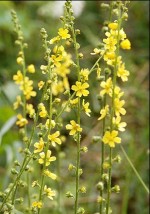
Agrimony is a perennial herb native to Europe and sothwestern Asia where it grows in moist woods, damp meadows, pastures, and along stream banks. It is a member of the rose ramily, Rosaceae, that also includes cherry, almond, and lady’s mantle. The plant has a deep rhizome and a slightly rough, hairy, sparingly branched, stem. The pinnately compound leaves are deep green, downy, 7-8″ at the base, up to 3″ above, and have leaflets 1-1.5″ long with wavy margins. Clusters of yellow flowers appear in summer and have an urn-shaped flower-cups with bristles on the fringe, five egg-shaped petals, 5 sepals, and 5-20 extruded stamens with pollen that attract hoverflies, flies, honey bees and butterflies. The flowers give way to fruits with bristly burrs that aid in seed dissemination. The whole plant is slightly aromatic but the flowers have a spicy fragrance. Agrimony has a long history as a medicinal herb and is attractive when grown in naturalized areas, rock garden, wildflower border, or an herb garden. The genus name, Agrimonia, is a misrendering of argemonia, from the Greek name Argemone, which refers to the plants ability to heal the eye. The specific epithert, eupatoria, is the Greek name for bonset and suggests the medicinal use of the plant.
Type: Herbaceous perennial herb
Bloom: Five petaled yellow flowers 1/4″ across are borne in racemes in summer.
Foliage: Deep green serrated pinnately compound downy leaves ranging in size from for 3-8” long.
Size: 1-5’ H
Light: Light shade
Soil: Average, dry, well-drained; tolerant of a wide range of pH
Fertilizer: None needed
Hardiness: Zones 6-10
Care: Low maintenance
Pests and Diseases: Susceptible to powdery mildew
Propagation: Seed (will reseed).
